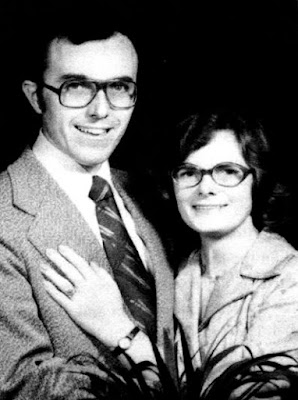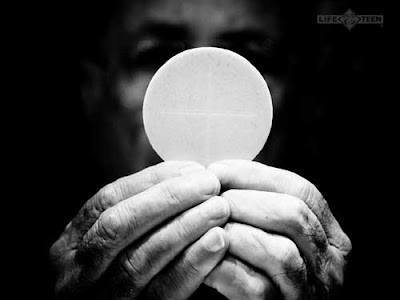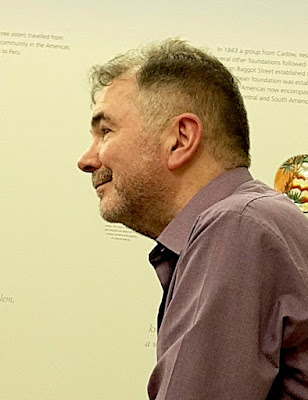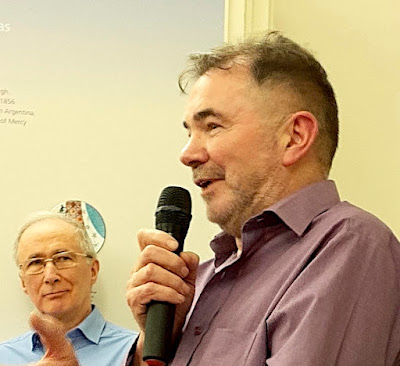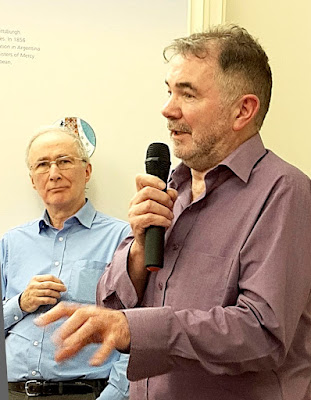Question?
Did the Inquisition (CDF) contribute to Fr. Tony Flannery's spiritual development?
Surprisingly, the answer is YES.
And we have it in his own words, in the acknowledgements section of
his latest book.
Lastly I must acknowledge the part played by the Congregation for the Doctrine of the Faith. Without their intervention in my life neither this book, nor my previous one, A Question of Conscience, would have seen the light of day.
And who can deny, reading both books, that they have played a significant part in Tony's spiritual, intellectual, and emotional development over the last eight years of his banishment from ministry.
It is interesting to contrast this with the "spiritual development" of the CDF over the same period. Zilch.
Its head in 2012, Cardinal Lavada, has since been pulled over for drink driving and his immediate successor is now one of the leading lights in the opposition to Pope Francis's attempts to drag the church screaming into the 20th, let alone the 21st century. Cardinal Lavada has since gone to meet his maker and that is a conversation at which I'd love to be a fly on the wall.
The CDF "terms of surrender" furnished, indirectly as usual, to Tony this year virtually replicate those set down in 2012.
The only advance is the CDF being caught out yet again by Tony's insistence that they lacked the guts and/or manners to engage with him directly in all of this. The current CDF head, Cardinal Ladaria (Brother Luis to you), publicly claimed that they had tried to engage with him but that he had refused. Imagine the extent of potential embarassment that led this Prince of the Church to lie in public.
What I'm sure he meant, or should have meant, to say was that they had got a negative reply from Tony to the outrageous unsigned unheaded "surrender terms" furnished, as usual, through Tony's international superior, Fr. Brehl, the cowardly fall guy in all of this.
So, down to business - the book.
The book is the fruit of a journey, which you might be surprised to learn both Tony and I share. From Pius XII to Francis, though I travelled earlier and ended up further down the road. Tony discovered an acceptable halting site along the way.
For a Catholic priest it is surely "The Road Less Travelled", at least in terms of introspection and courage. But people today will be aware that for many Catholics it is becoming the Road More Travelled in the face of the obduracy of the CDF continuing to peddle outmoded concepts, not to mention the actual corruption in that institution and in the wider Vatican.
Some Details
I'm going to take each chapter one at a time, give you a very rough idea what's in it with some comments of my own. I'll be doing this in very summary fashion or I'd be here all night.
Before I do, I'd like to stress that this is a most important book whose central thesis will hopefully be accepted over time by the faithful but which for the moment represents a radical revolution in belief. The text is considered and tightly written and I have complimented the publisher on their choice of font which is most readable.
Foreword by Kevin Hegarty
The choice of author for the Foreword speaks volumes.
Kevin Hegarty was sacked in 1994 as editor of the Catholic Church magazine, Intercom, after commissioning articles on subjects like clerical sexual abuse, women priests and compulsory celibacy. When he was appointed to the job of editor in 1991 he was regarded as one of the rising intellectual forces in the Irish Catholic Church.
He was effectively banished to Hell and Connacht. It's a wonder someone didn't trump up a few abuse charges against him as is the wont these days in the case of unwelcome whistleblowers.
Anyway, Tony picked a good man for his foreword and sent out a message at the same time.
Chapter 1 We Are Where We Are, But How Did We Get Here?
In this introductory chapter Tony describes how he more or less drifted into the priesthood. He also reveals that he was abused as a youth though he is inclined to minimise the after effects.
 A Distant Vengeful God
A Distant Vengeful God
He sets out the religious environment of the day in which guilt seemed to be the main ingredient and one which was intensified in the single sex Redemptorist seminary. The God of those days was seen as a vengeful King from a distant planet despite all the talk about infinite mercy and its implied empathy.
He stresses the great lift and hope that the Vatican Council brought to the table but he also reminds us of that unholy earthly trinity, John Charles, Connie Lucy, and Michael Browne, who did their best to douse the flames of reform and hope.
In one sense Vatican II came about 400 years too late. As Tony implies, the knee jerk reaction of the church to the Reformation did it no favours and an oppressive authoritarian hierarchical church festered in the hearts of the people thereafter. When Vatican II did come it was like a blood letting for many but the flow was quickly staunched by, among other things, the disastrous and cowardly encyclical
Humanae Vitae in 1968 which gave many, including myself, a rational and proximate reason for questioning, and in my case rejecting, church teaching.
Tony regrets the baby being thrown out with the bathwater and he has a point.
Chapter 2 The Divine Mystery: Who, What, Where Is God?
For me, this chapter is what the book is all about. The external tyrant is replaced by an interior God whose intervention, if it exists, is more diffuse and strictly personal.
This is a difficult concept to come to terms with in the first place. And it has very widespread implications which appear to me to be totally at variance with the current teaching of the Church.
It is not a new idea. I first came across it with Anglican Bishop John Robinson's book,
Honest to God, in 1963. But coming to this point takes honesty and lots of courage. It is not initially a comfortable place to be in terms of your own belief and, of course, the potentially violent reaction of a declining church.
At the same time I was reading Paul Tillich's The Shaking of the Foundations and Tony's book seriously merits this description. These were the two books I used to bring to mass while in my transition phase.
The implications of this internal God remain to be teased out. The concept undermines a lot of what we had learned to live with and challenges many of the specifics which it has been the progrogative of the clergy to explain to us, or indeed threaten us with.
The concept of Hell springs to mind. In his Portrait of the Artist James Joyce retails a description of Hell in all its gruesome details. The missionary priest he quotes is, of course, fictional but the description captures the experience as no doubt promulgated by many a missionary in those days. Who knows, with the reputation of the Redemptorists of putting the fear of God into you at mission time, maybe Tony himself doled out some of this in his day.
It is a challenge to the Real Presence as conventionally understood in Catholic doctrine. Now, our understanding of this magical process arises in part from Thomas Aquinas's distinction between the substance and its accidentals, a distinction that does not lie easily with the science of today. Nevertheless, the knee jerk response of the Curia to any meddling with the Real Presence, despite the science underpinning it being well past its sell by date, is no joke and no doubt Tony will encounter some serious blowback on that one.
The Curia is incapable of seeing that even if something is symbolic it is none the less real, as Tony himself has pointed out on a previous occasion. But the attitude taken now, and at the time of the Reformation, is that any challenging of the specifics is a challenge to the power and control of the Curia, and we couldn't have that now, could we?
Concepts up for reconsideration include Hell, Heaven, in fact the afterlife itself, indulgences, the immaculate conception as a unique occurrence, the virgin birth, the resurrection and assumption, the real presence, and so on.
So we're into lots of serious stuff here. But don't blame Tony. Blame the church's reaction to the Reformation and its insistence on the ineffable and the infallible.
Tony sums up his present belief in God as follows:
I am now more comfortable with the notion of a divine presence at the heart of creation, a divine presence within each one of us, a divine presence that is continuously creating and who involves us as essential partners in this ongoing act of creation. This divine presence is not distant, far away, in a heavenly realm, but is part of us, and is keeping everything in existence with an almightly and enduring love. This is not the pantheism of old, it is not suggesting that everything is divine, but rather that every aspect of creation is infused with the Divine Spirit.
For me, this is Tony exploring his halting site. This new diffuse God leaves many questions unanswered. For example can you pray to it or is prayer now simply an internal reflection and a mechanism for self improvement.
This sort of question may be the subject of another book down the road. To give Tony his due, one concept he doesn't throw out is that of "mystery". Traditionally this has been invoked by the Church when it hits an uncomfortable collision between conflicting aspects of belief.
For Tony it is a bit more positive, a question mark to be explored further. There is a concept where not just a belief in God is evolving but so is the godhead itself - "God in process".
Tony does believe in a guiding hand and a loving presence but the nature of this and how it fits in to this new idea of God is still to be resolved. A mystery for now.
Chapter 3 What Do We Mean When We Say Jesus Is the Son of God?
Never a man to shirk a challenge, Tony now tackles Jesus. Questions now abound. What is the God that Jesus was the son of?
Tony starts by interrogating the Gospels. These were effectively written after the event as propaganda, so what was the actual truth underlying them. Was Jesus special, and if so in what way? How is he divine above his contemporaries. Tony is prepared to leave this in the mystery category also. There are no precise answers. Christ was not Jesus's surname it was given to him subsequently to identify him as the long awaited saviour.
Tony prefers to concentrate on the life of Jesus and what his real underlying message is for us today. He was a teacher and a subversive, at least as far as the corrupt Jewish establishment is concerned. Perhaps his resurrection refers to the persistence and blossoming of his teaching after his death. It is not his body but his persisting presence that is involved in the resurrection. The symbolic is none the less real. But this is a really difficult one for those raised in the traditional faith to get their head around.
In an interview with Canadian radio, many years back, Tony said he had no problems with the Creed. That is no longer the case. A new edition is called for.
In rejecting the idea of original sin, Tony sets the cat among the pigeons. Why should we not all be born in the "state of grace"? This really deprives the Curia of one of its main weapons in subjugating the faithful and at the same time puts a huge emphasis on personal responsibility. I am sorry Seán Fagan is no longer with us to celebrate this one. Do I hear an other-worldly chuckle in the back of my head?
I realise that in simply referring to Tony's current beliefs and areas of remaining mystery I am doing them an injustice. In some ways Tony's book is more of an infusion than a text and I am just touching on the table of contents. You need to read the book with an open mind to appreciate what he is getting at and you need to accept his mysteries in good faith to understand what he is at. If, having read the book, you are unaffected and prefer the traditional version, that is your prerogative but you will hopefully find this more unsettling than before.
Chapter 4 Mary's Place in the Church
His discussion of Mary traditionally "the mother of God" raises many more difficult questions. What is the meaning of the immaculate conception. In traditional church terms it was a logical necessity. If Jesus was God he could only be born of a woman who had never suffered the stain of sin, even original sin. But now that original sin is obsolete we are all immaculate conceptions.
And the virgin birth. This arose to keep Mary's womb exclusive to Jesus and not have it invaded by ordinary folk who might contaminate it along the way. And then, what might be the claim of any brothers and sisters of Jesus to somes share in his divinity.
So what do I now believe about Mary the mother of Jesus? I accept the general understanding of scholars that the stories of the conception and birth of Jesus are mythological rather than historical. [...] These myths are not unique to the Christian story, but bear a striking resemblance to many ancient myths about gods and the children of gods, and about gods coming down and having sexual relationships with women on earth.
I remember my own shock when first reading WB Yeats poem
Leda and the Swan.
No surprise then that Tony reflects:
I find it difficult to write about the place of Mary in our faith. I spent a great part of my priestly life conducting popular devotions to Our Lady under the title of Our Mother of Perpetual Help. Thus I had ample evidence of how much she means for many Catholic believers. I think it is true to say that a large part of popular devotions are directed more to Our Lady than to God.
It is therefore a measure of his courage and integrity that he has not let this deter him from seeking the truth, difficult and all as that must be for him.
So what is the Mary we are left with at the end of this chapter?
We can see her as a human being, a mother and a wife, who struggled with all the same problems as any woman in a relationship and rearing a family. In this way she can become for us less of a remote, heavenly figure and more of a real flesh-and-blood human person who lived life much as we ourselves have to live it.
Chapter 5 The Church's Fatal Flaw: Exclusion of Women
I'm not going to dwell on this one. It is clear to me, and to Tony, and to hosts of other thinking people, that the exclusion of women from the highest offices of the Church has not one whit of foundation in scripture or in theology. Its function was to copperfasten the boys club and nothing else.
So there is no reason not to ordain women priests. There is a difficulty however as the priesthood itself is in need of serious reform so why would women want to be priests as currently defined. So, the ordination of women and reform of the priesthood must go hand in hand. Meanwhile ordaining women deacons is a step along the road.
Tony takes the opportunity here to discuss the evolution of the invidual conscience, Vatican II and its quick subversion by Paul VI's Humanae Vitae.
Chapter 6 Discovering that Religious Men and Women Were Abusing Children
This picture kills two birds with the one stone. The priest, Morgan Costello, is celebrating the Eucharist while the nuns of the convent are off to the side in a railed enclosure. They were not then even allowed to be altar servers as I was. I am the server on the left.
But the punch line here is that Morgan Costello was much much later identified by the Gardaí as probably the most prolific child sex abuser in the land, worse even than Brendan Smyth. And he was a very nasty man to boot. That did not stop him holding respectable positions in the church and being transferred around Dublin parishes by those who must have known about his nefarious activities. He even went in to the Ryan Commission on a delegation with Fr. McVerry.
And the church, which did nothing about him other than eventually defend him behind a battery of civil and canonical lawyers, is making a fuss about the ordination of women. C'mon.
Chapter 7 The Roots of the Problem
Here Tony discusses a number of issues. Clericalism is prominent among these. Tony quotes Bishop Long of Australia describing the clerical church as "becoming the church of the ordained at the expense of the baptised". Clericalism has to go and this implies a radical change in the idea of the priest. The priest is there to serve and not to be served.
Tony explores the current training for the priesthood and the stunting of sexual growth which it implies. Not a full explanation but no doubt a contributory factor to clerical abuse. There is no reason why celibacy should be a precondition for the priesthood. It has its place, but the current global requirement is effectively deterring a significant number of people who would be good priests.
You also have to consider that the priesthood is/was one of the professions/callings which does have unfettered and unsupervised access to children - historically, young boys. This brings with it the responsibility to have a sexually mature and responsible priesthood.
I'm quite sure that Costello did not interfere with any of us altar boys in the convent where I served his masses. I put this down to the lovely but firm nun who supervised the altar boys. But when he went out into the parishes he had unsupervised access to young boys, and to the Church's shame, this continued for the rest of his clerical career.
Chapter 8 Mass Requires Community Participation
Given the Church's reliance on history and tradition, I have often thought that a mass based on the traditional view of the Last Supper would require a quorum of 13 males but no more, one of whom was in the state of mortal sin. And definitely NO WOMEN.
My feeling is that, following Vatican II, the mass now in the vernacular revealed the poverty behind the mystery. The nature of the event should have changed with an emphasis on participation rather than the magic. But it didn't.
Tony tells us how he more recently discovered the mass as a participant rather than a celebrant and he finds the experience wanting.
I am not in the least surprised. The mass, while traditionally revered by the faithful, was effectively a form of purgatory redeemed only by the magic. Now that the magic is questioned and the mass stripped of its mystery, it is an event in search of a purpose. We are still a long way from the joy of the charismatics; the mass does need to be transformed into a human experience of consequence and a reaffirmation of life and hope.
In Tony's own words
the current text of the mass has amplified an old theology that no longer makes sense to the majority of the believing community.
In this chapter Tony challenges the dissection of the person into body and soul the latter being the priority at whatever cost to the former. He has come to a more holistic view of the person, which in turn leads to more attention to this life and again undermines the traditional environment which played into the hands of the control freaks in the CDF.
Tony examines the many complexities of the mass and the conflict between those who want to see it as a means of spiritual renewal and the others who see it as a means of control. He ends up with a very progressive and ecumenical view:
Nowadays, many people, including myself, who still believe that Jesus is present in the celebration of the mass, are not inclined to try to explain it in this or any other fashion, but are happy to leave the 'how' of his presence in the realm of mystery, something to be experienced rather than explained, and we would be very slow to say that he is not present in other Christian celebrations.
I would sum all this up with a passage from another author from some twenty years ago, a passage which harks back to Hans Kung and the Vatican Council.
The Vatican Council struggled with two conflicting paradigms of the Church. The medieval model saw the Church as a clerical and hierarchical institution with sacred power percolating down from the top. An earlier, scriptural model on the other hand considered the Church rather as the People of God, with stress on communion, co-responsibility, and Christian values such as grace and love. Though it could not free itself totally from the hierarchical model, the Second Vatican Council did attempt to promote the People of God concept.i The authorities in Rome on the other hand cling firmly to the hierarchical model and try to re-inforce what has recently been called “a very authoritarian, absolutist, completely un-Christian structure”. It has become clear that an integration of the best in both models can only be achieved by a genuine reform in the way the Church operates.63
63 H. Küng, ‘The Charismatic Structure of the Church’, Concilium 4,1 (April 1965) pp. 23-33; G. Hasenhüttl, Charisma, Ordnungsprinzip der Kirche, Freiburg 1969; H.Haag, Worauf es ankommt. Wollte Jesus seine Zeit-Stände-Kirche?, Freiburg 1997; L. Boff, ‘The Uncompleted Vision of Vatican II: The Church - Hierarchy or People of God?’, Concilium 38/3 (June 1999) pp. 31 - 39; see also the last chapter in this book.
Source: The Ordination of Women in the Catholic Church - Unmasking a Cuckoo’s Egg Tradition, John Wijngaards, Darton, Longman & Todd Ltd, London, 2001, p 29.
Chapter 9 Can We Say Anything with Conviction About Eternal Life
The next life, overdefined, has alway been the key to the maintenance of clerical power.
But what sort of afterlife does Tony expect as he meditates on death, as I do myself, in the departure lounge. One thing is sure. He will no longer guarantee that you will meet your granny up above, on the assumption that she has not opted for the other place.
When we talk about eternity we tend to think of ourselves as individuals, we question where we will go, who we might meet again and if we will be the same as we are now in this world. Traditionally we would refer to the salvation of our souls. However, I believe that, unlike the conventional notion of soul, the spirit that is in us is not an individual thing. Rather it is the same Divine Spirit that infuses and energises everything, that permeates the cosmos. It cannot die, and consequently neither can we die, in the fullest sense of that word. I believe that in some mysterious way we will be absorbed more fully into the Divine.
Chapter 10 Faced with Enormous Challenges, Is There a Future for Our Church?
What I wish to do in this chapter is outline the implications of my views about our faith for our Church; in other words the type of Church that would, in my opinion, be best suited to promote the message of Jesus of Nazareth to the modern world.
First question, is the Church today the Church of Jesus? Did he found it and is it the way he would have wanted it?
The answer is clearly NO and NO. So where do we go from here.
Tony has a long shopping list for what needs to change in the Church: the Pope as Supreme Ruler, a synodal Church, defenestration or abolition of the CDF, equal footing with other Christian churches, bishops chosen by popular suffrage, married priests, women priests, more open priestly formation, laity involved in church governance, and more. These are all touched on.
Tony's final paragraph:
One way or another there are stormy times ahead for our Church. Many battles will be fought and there will be deep divisions, and possibly splits and breakaway groups. I like the summary given by American writer Micheal Bayer, writing about the radical changes needed in the Church. 'The purgation will hurt. Smashing the patriarchy, extirpating the racism, eliminating the privilege and the self-satisfaction and the moral superiority is going to be painful as hell for a 2000-year-old institution that has accumulated much that has nothing to do with the gospel.'
Epilogue: The Terms of Surrender
Tony has added insult to injury by reproducing, at the end of the book, the Trumpian declaration of loyalty which the CDF wants him to sign.
The document sets out a number of doctrinal positions to which Tony is asked to submit as follows:
- No women priests
- Homosexual practices are contrary to the moral teaching of the Church
- Marriage, other than between a man and a woman, is not allowed by the Church
- Gender Theory is not accepted Catholic teaching
And the prize:
After the statement is signed and received a gradual readmission of Fr. Flannery to the exercise of public ministry will be possible by way of an agreement with this Congregation. Furthermore, given the fact that he has stated numerous times that he is not a theologian, he should be asked not to speak publically on the above-mentioned topics which have caused problems in the past.
This is a piece of arrogance typical of the Inquisition, a moniker which the CDF is currently trying to shed - unsuccessfully as far as I'm concerned.
I think I can safely leave you to work out this move for youself and you will not be surprised that Tony has refused to have anything to do with it.
 At the Catholic Truth Conference, Judge O'Brien K.C.
At the Catholic Truth Conference, Judge O'Brien K.C.











































